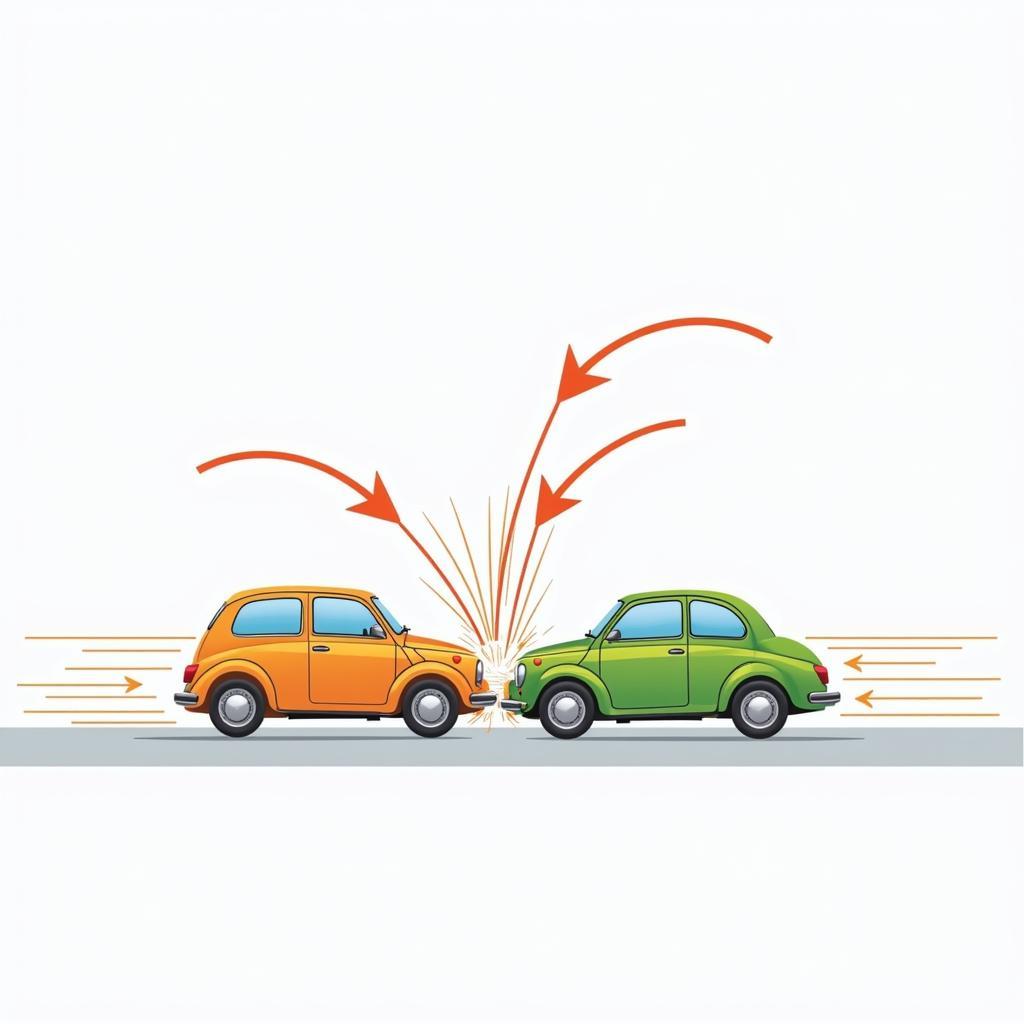Understanding the physics of car collisions is crucial for accident reconstruction and vehicle safety improvements. While velocity is a key factor, many collision problems can be analyzed even without knowing the initial speeds. This article explores how we can deduce information about a collision using principles like conservation of momentum and energy, focusing on scenarios where velocity isn’t readily available.
Focusing on the “Car Collision Physics Problem Without Velocity” allows us to delve into the core principles governing impacts. We’ll explore how factors like vehicle mass, damage patterns, and the post-collision state can provide valuable insights. This knowledge is essential for anyone involved in automotive repair, accident investigation, or simply wanting a deeper understanding of collision dynamics.
Analyzing Collisions Using Conservation of Momentum
Even without initial velocities, the principle of conservation of momentum remains a powerful tool. This principle states that the total momentum of a closed system remains constant before and after a collision. Momentum is calculated as the product of mass and velocity. Therefore, in a two-car collision, the combined momentum of both vehicles before impact equals their combined momentum after impact.
For example, if two cars collide and stick together, we can determine the velocity of the combined mass immediately after the collision using the masses of the individual vehicles and their final, shared velocity. This allows us to work backwards, often in combination with other evidence, to estimate the pre-collision speeds.
two cars stick together collision physics problem
Utilizing Energy Principles in Collision Analysis
The law of conservation of energy also plays a vital role. While kinetic energy (energy of motion) is not conserved in inelastic collisions (where some energy is lost to heat, sound, and deformation), the principle of energy conservation can still be applied. We know that the initial kinetic energy is transformed into other forms of energy during the collision. By analyzing the extent of vehicle damage, we can estimate the energy dissipated, giving us clues about the forces involved and potentially the initial velocities.
For instance, the severity of the damage, such as the degree of crushing or deformation, provides a measure of the energy absorbed during the impact. This, in turn, can be related back to the initial kinetic energy and thus, the initial velocities. This approach is particularly useful in situations where skid marks are absent or unreliable.
Determining the Coefficient of Restitution
The coefficient of restitution (COR) describes the “bounciness” of a collision. It ranges from 0 to 1, where 0 represents a perfectly inelastic collision (the objects stick together) and 1 represents a perfectly elastic collision (no kinetic energy is lost). By observing the post-collision movement of the vehicles—whether they bounce apart or remain entangled—we can estimate the COR. This value can then be used in conjunction with momentum conservation to further refine our understanding of the collision dynamics.
 Coefficient of Restitution in Car Collision
Coefficient of Restitution in Car Collision
Applying Collision Physics to Accident Reconstruction
Accident reconstruction specialists utilize these physics principles to piece together the events of a collision. They examine the final positions of the vehicles, the damage patterns, and other physical evidence like tire marks and debris. Even without knowing the initial velocities, they can often determine the sequence of events, the point of impact, and even estimate the pre-collision speeds. This information is critical for legal proceedings, insurance claims, and improving vehicle safety standards.
[momentum and collision problem c a race car](https://autotippro.com/momentum-and-collision-problem-c-a-race car/)
The Importance of Expert Analysis
While basic physics principles can provide valuable insights, analyzing a car collision without velocity information often requires specialized knowledge and tools. Experienced accident reconstruction experts use sophisticated software and detailed analysis techniques to model collisions and determine the most likely scenario. Their expertise is crucial for accurately interpreting the physical evidence and arriving at reliable conclusions.
Conclusion
Even without knowing the initial velocities, understanding the physics of car collisions—specifically focusing on “car collision physics problem without velocity”—can provide invaluable insights. By applying principles like conservation of momentum and energy, analyzing damage patterns, and considering the coefficient of restitution, we can reconstruct the events of a collision and gain a deeper understanding of the forces involved. This knowledge is crucial for accident investigation, vehicle design improvements, and ensuring safer roads for everyone. For further assistance or specialized analysis, connect with us at AutoTipPro at +1 (641) 206-8880 or visit our office at 500 N St Mary’s St, San Antonio, TX 78205, United States.





Leave a Reply